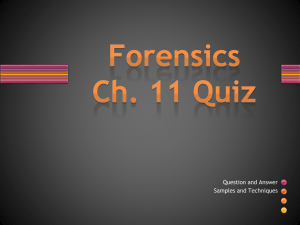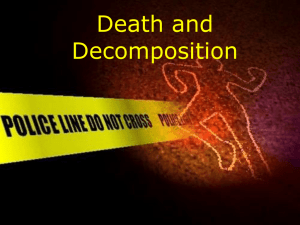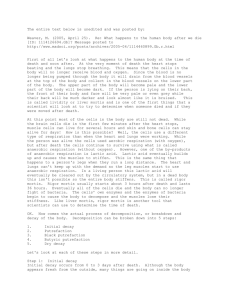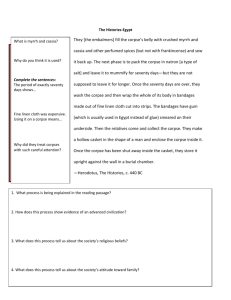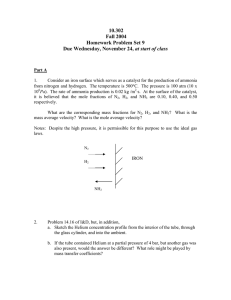Forensic Science Notes – Death and Decomposition
advertisement
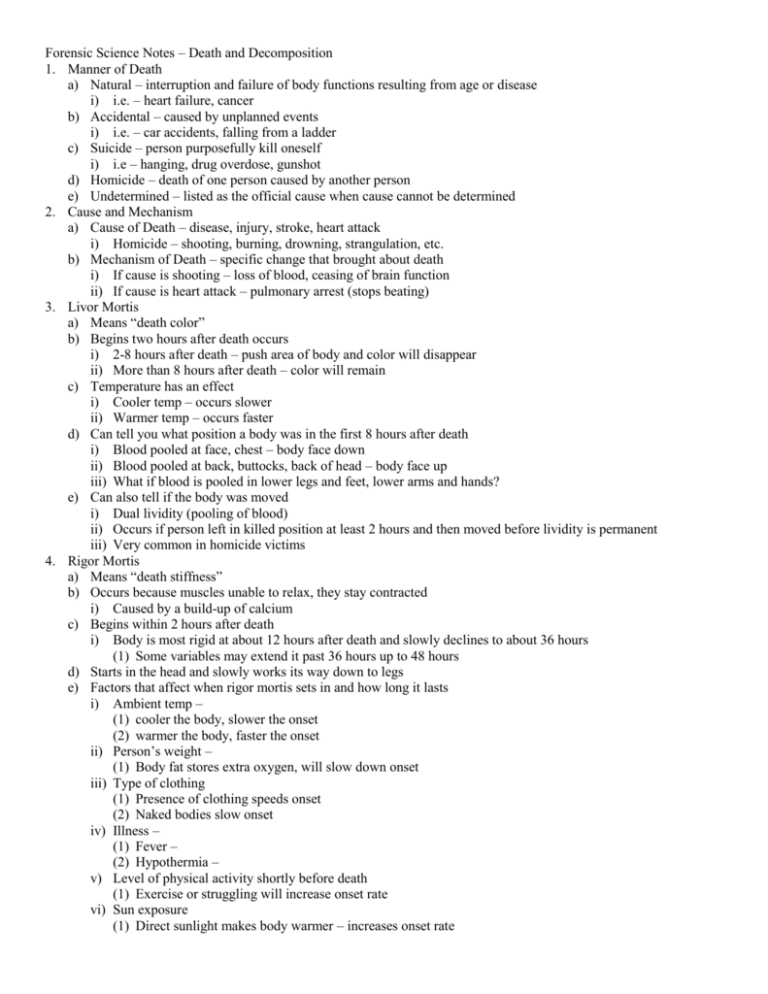
Forensic Science Notes – Death and Decomposition 1. Manner of Death a) Natural – interruption and failure of body functions resulting from age or disease i) i.e. – heart failure, cancer b) Accidental – caused by unplanned events i) i.e. – car accidents, falling from a ladder c) Suicide – person purposefully kill oneself i) i.e – hanging, drug overdose, gunshot d) Homicide – death of one person caused by another person e) Undetermined – listed as the official cause when cause cannot be determined 2. Cause and Mechanism a) Cause of Death – disease, injury, stroke, heart attack i) Homicide – shooting, burning, drowning, strangulation, etc. b) Mechanism of Death – specific change that brought about death i) If cause is shooting – loss of blood, ceasing of brain function ii) If cause is heart attack – pulmonary arrest (stops beating) 3. Livor Mortis a) Means “death color” b) Begins two hours after death occurs i) 2-8 hours after death – push area of body and color will disappear ii) More than 8 hours after death – color will remain c) Temperature has an effect i) Cooler temp – occurs slower ii) Warmer temp – occurs faster d) Can tell you what position a body was in the first 8 hours after death i) Blood pooled at face, chest – body face down ii) Blood pooled at back, buttocks, back of head – body face up iii) What if blood is pooled in lower legs and feet, lower arms and hands? e) Can also tell if the body was moved i) Dual lividity (pooling of blood) ii) Occurs if person left in killed position at least 2 hours and then moved before lividity is permanent iii) Very common in homicide victims 4. Rigor Mortis a) Means “death stiffness” b) Occurs because muscles unable to relax, they stay contracted i) Caused by a build-up of calcium c) Begins within 2 hours after death i) Body is most rigid at about 12 hours after death and slowly declines to about 36 hours (1) Some variables may extend it past 36 hours up to 48 hours d) Starts in the head and slowly works its way down to legs e) Factors that affect when rigor mortis sets in and how long it lasts i) Ambient temp – (1) cooler the body, slower the onset (2) warmer the body, faster the onset ii) Person’s weight – (1) Body fat stores extra oxygen, will slow down onset iii) Type of clothing (1) Presence of clothing speeds onset (2) Naked bodies slow onset iv) Illness – (1) Fever – (2) Hypothermia – v) Level of physical activity shortly before death (1) Exercise or struggling will increase onset rate vi) Sun exposure (1) Direct sunlight makes body warmer – increases onset rate 5. Algor Mortis a) Means “death heat” b) Thermometer inserted into liver as standard c) Timeline: i) 0-12 hours after death: 1.4°F per hour ii) > 12 hours after death: 0.7° F per hour until reaching surrounding temp d) Factors affecting heat loss: i) Cooler environment – loses heat faster ii) More body fat, clothing – loses heat slower 6. Other Factors also Used for Time of Death a) Stomach Contents b) Potassium present ocular fluid 7. Stages of Decomposition a) Within two days after death: Initial Decay i) Cell autolysis begins. ii) Green and purplish staining occurs from blood decomposition. iii) Skin takes on a marbled appearance. iv) Face becomes discolored. b) After four days: Putrefaction i) Skin blisters. ii) Abdomen swells with carbon dioxide (released by bacteria living in the intestines). c) Within six to ten days: Putrefaction i) Corpse continues to bloat with CO2 as bacteria continue to feed on tissues ii) Eventually, gas causes chest and abdominal cavities to burst and collapse. iii) Fluids begin to leak from body openings as cell membranes rupture iv) Eyeballs and other tissues liquefy v) Skin Sloughs off 8. Stages of Decomposition Named! a) Initial Decay – 0-3 days b) Putrefaction – 4-10 days c) Black Putrefaction – 10-20 days i) Very strong odor ii) Parts of flesh appear black iii) Gases escape and corpse collapses d) Butyric Fermentation – 20-50 days i) Corpse is beginning to dry out ii) Most of flesh is gone e) Dry Decay – 50 days or more i) Corpse is almost dry ii) Further decay is slow due to lack of moisture 9. Factors that affect Speed of Decomposition a) Age i) Young decompose faster than elderly b) Size of body i) Overweight people decompose faster than smaller people c) Temperature i) Naked bodies decompose faster than clothed bodies ii) Higher temps preserve corpses iii) Lower temps prevent bacterial growth, slow decomposition d) Environment i) Bodies decompose more quickly in air (oxygen rich) ii) More slowly in water, or buried 10. Forensic Entomology a) Forensic Protocol to Collect Insect Evidence: i) On Body ii) Above Body iii) Below Body iv) Surrounding Environment 11. Common Insects of Decomposition a) Any insect containing maggot stage of life i) Most common is blow fly b) Tiny wasps – lay their eggs i) Larvae live inside maggots as parasites c) Cheese Skippers i) Attracted to seeping bodily fluids d) Mites and Beetles i) Favor drier conditions 12. Life Cycle of Blow Fly a) Egg b) Three Larval Stages (aka instar) c) Early and late pupal stage d) Adult When first Stage appears Stage Duration Characteristics Egg Larva 1 (Instar 1) Larva 2 (Instar 2) Larva 3 (Instar 3) Soon after death 8 hours 1.8 days 20 hours 2.5 days 15-20 hours 4-5 days 36-56 hours Found in moist, warm areas of body. Mouth, ears, anus 1 spiracle slit near anus Thin body 2 spiracle slits near anus Starts feeding 3 spiracle slits near anus Fat body Pre-pupa 8-12 days 86-180 hours Larvae start to migrate away from body Early and late pupa stages 18-24 days 6-12 days Adult 21-24 days Several weeks Immobile, doesn’t feed Changes to dark brown Hatched from larvae Immobile for first few hours 13. Time of Death and Blow Fly Stage a) If a corpse contains blowfly eggs the approximate time of death would be 24 hours or less. b) If a corpse contains third-stage larvae, time of death is approximately 4-5 days. c) If a corpse contains pupae, time of death would be approximately 18-24 days. 14. Factors that affect Insect Development a) Temperature b) Moisture c) Wind d) Time of day e) Season f) Exposure to elements g) Variations among individual insects h) Use of insects to predict time of death is only an estimate! i) All environmental variations must be recorded at time of collection!!!!! 15. Accumulated Degree Hours (ADH) a) Preserve some insects from the crime scene so you know exactly how old they are at the time of discovery of the body. b) At the crime lab, raise some of the insects from the crime scene in the same conditions of those at the crime scene. c) Record the length of time for development under the specific conditions found at the crime scene. d) Compare the insects raised at the crime lab to those found at the crime scene. 16. Other forensic uses for entomology include: a) If insects from another region are found, body was most likely moved

